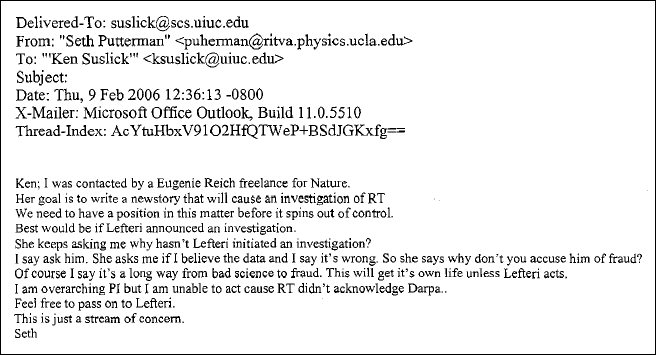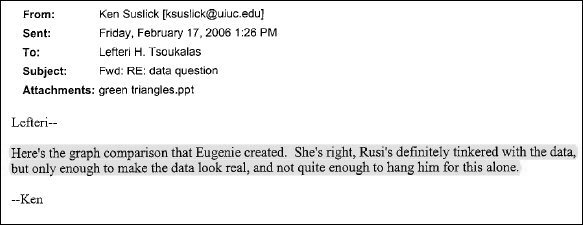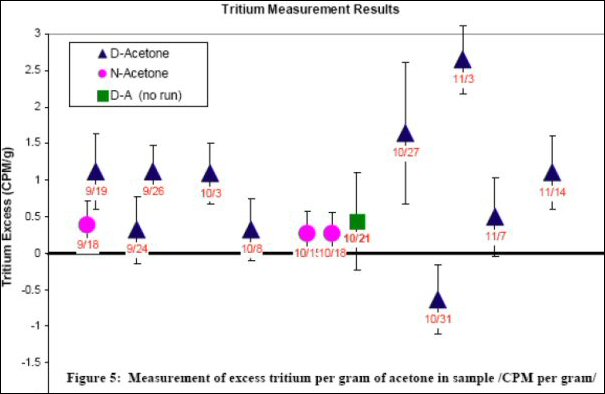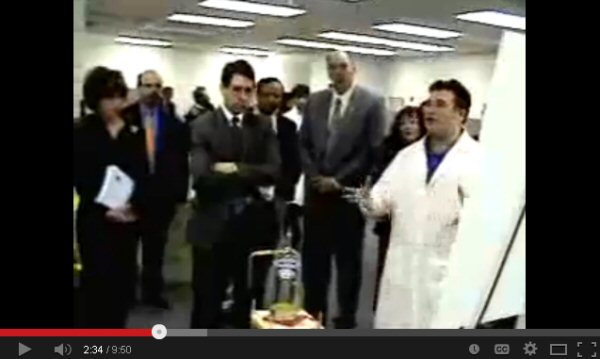Federal Investigations Reveal Academic Backstabbing at Purdue University (Part 6)
New Tribunal
Tsoukalas began to cooperate with Reich and to further distance himself from the research. On Feb. 7, 2006, Tsoukalas began to fix the discrepancy between what he had told Reich and what Butt had told her. Tsoukalas formed an unauthorized tribunal that he called a Fact-Finding Committee, whose purpose was to investigate not Taleyarkhan but Xu, Butt and Revankar. The committee also fixed the discrepancy.
The three-member committee, operating in violation of the university’s policy for research integrity, obtained an unsigned document from Butt in which he denied having anything to do with the research. Xu, who did not understand his rights, appeared before the tribunal. Revankar was familiar with the Purdue policy on research integrity and, because of this, and despite significant pressure from the committee, refused to appear before it.
On Feb. 9, 2009, Putterman wrote to Suslick, “I was contacted by a Eugenie Reich, freelance for Nature. Her goal is to write a news story that will cause an investigation of Rusi Taleyarkhan.”

The e-mail is retyped here for clarity:
Ken, I was contacted by a Eugenie Reich freelance for Nature.
Her goal is to write a newstory that will cause an investigation of RT.
We need to have a position in this matter before it spins out of control.
Best would be if Lefteri announced an investigation.
She keeps asking me why hasn’t Lefteri initiated an investigation?
I say ask him. She asks me if I believe the data and I say it’s wrong. So she says why don’t you accuse him of fraud?
Of course I say it’s a long way from bad science to fraud. This will get its own life unless Lefteri acts.
I am overarching PI but I am unable to act [be]cause RT didn’t acknowledge DARPA [The PRL paper was funded by DoE, not DARPA.].
Feel free to pass on to Lefteri.
This is just a stream of concern.
Seth
According to a Feb. 9, 2006, e-mail from Reich, Tsoukalas had suggested to her the possibility of science fraud by Taleyarkhan. According to additional FOIA-obtained e-mails, Tsoukalas then talked things over with Putterman and Suslick. Afterward, Tsoukalas wrote back to Reich and attempted to retract his accusations of fraud. He characterized his comments as merely “poetic license and dramatic language” and told Reich that he did not have evidence of fraud. Tsoukalas also asked her to treat his previous on-the-record comments as confidential.
The e-mail trail does not indicate that she agreed to accommodate Tsoukalas’ request, and Reich showed no signs of backing off the story she thought she had.
Reich had a first draft of her story ready the next day and offered to read it to Tsoukalas. A day later, she told Tsoukalas that she might publish her story at the end of the following week.
“Therefore,” Reich wrote, “as I said before, I would like to go through the story I would like to publish with you on Monday.”
Reich delayed the story, although she was nervous about Tsoukalas leaking it and about getting “interference” from the Purdue administration. In her own words, she had now become part of a conspiracy with Tsoukalas:

“If I am, so far, holding the story until at least next week, it’s because I’m trusting you not to 1) make a press release or 2) prevent everybody speaking with me in future and disown true information about what happened. Then I would be mad with you and regret becoming part of a conspiracy, and I would also regret not publishing sooner.”
Reich, Putterman and Suslick exchanged several more e-mails in the next few days. Reich had apparently done her own data analysis and speculated that Taleyarkhan had manipulated data.
“Lefteri,” Suslick wrote, “here’s the graph comparison that Eugenie created. She’s right, Rusi’s definitely tinkered with the data, but only enough to make the data look real, and not quite enough to hang him for this alone.”

On Feb. 17, 2006, the Tsoukalas-appointed committee, led by Purdue professor of nuclear engineering Chan Choi, along with retired professors Karl Ott and Franklyn Clikeman, met with Butt. Butt was not represented by counsel and was not advised of his rights or of the university procedure for research integrity concerns.
According to Darla Mize, Tsoukalas’ administrative assistant, the meeting took place in his office with Tsoukalas present. No minutes from the meeting were kept. After a follow-up meeting on Feb. 22, Butt sent the committee a one-page unsigned document titled “Timeline of Events” on Feb. 23, 2006.
On Sept. 12, 2008, New Energy Times spoke with Butt. He declined to answer questions. We sent him a follow-up letter with questions and an invitation to respond. He did not respond.
The first three paragraphs were written in third person; the rest of the page was written in first person. The statements in Butt’s “Timeline of Events” directly contradicted the statements he provided to Reich on Feb. 6, 2006. His “Timeline of Events” also contradicted the four-page summary he wrote of his Sonofusion Lab 2004 Summer Activities on Aug. 6, 2004. His “Timeline of Events” is also contradicted by the fact that he wrote his master’s thesis on the nuclear cavitation research.
But now the discrepancy was fixed. The statements in Butt’s unsigned document now matched what Tsoukalas told Reich.
In the document, Butt denied that he co-wrote the Nuclear and Engineering Design paper. This is the same paper for which he posed for a photo in a Purdue press release. Butt also insinuated that he had nothing to do with the research reported at NURETH-11. He denied that he was involved in the research, aside from moving hardware from a campus lab to an off-site lab. He denied that his name was on the NURETH paper from an earlier stage.
Parts of Butt’s document also matched the parts of Tsoukalas’ e-mail to Gore on Oct. 4, 2005. Thus, Tsoukalas effectively organized a committee that produced statements from his own student that supported Tsoukalas’ own accusations against Taleyarkhan. Butt, however, wanted to graduate, and Tsoukalas, the head of the school, was running the show.
According to a signed and sworn statement from Joseph R. Lapinskas, a student in the school, Tsoukalas may have had some leverage on Butt.
“While Adam Butt was finishing his master’s thesis,” Lapinskas wrote, “he spoke with Dr. Tsoukalas, and there was a rumor that he got pushed through his thesis faster than he should have.”
Until Butt was asked to appear before Tsoukalas’ committee, he appeared to his fellow students to be interested in and engaged in the nuclear cavitation research. He was even filmed giving a presentation for Purdue administrators on Feb. 20, 2005.
Butt was knowledgeable, confident and eloquent. He spoke enthusiastically about the possible energy and propulsion technologies that might come from his research, including for space travel and automobiles. More than that, he described his role in the research over the previous year.
Three Purdue administrators, as well as Tsoukalas, stood there as he gave his 10-minute presentation. Tsoukalas, Linda Katehi, the dean of Engineering, Sally Mason, the provost, Vincent Bralts, a professor and associate dean of resource planning and management in engineering and one other unidentified person all watched and listened. They all knew that Butt was clearly involved in the research.
On Feb 24, 2006, after Tsoukalas conducted his own unauthorized research-integrity inquiry, he sent an e-mail to Peter Dunn, the Purdue research integrity officer. He also sent it to Katehi. Tsoukalas informed them that Reich, working for Nature, was working on a news story. He informed them that professors Mamoru Iishi and Bertodano had sent him written research-integrity concerns. Tsoukalas also advised them that he had created his own ad-hoc investigation committee.
Tsoukalas knew Reich’s story was coming soon, but he didn’t have approval from the journal editor yet to submit his null-results paper.
“Dear Eugenie,” Tsoukalas wrote, “FYI. I have not heard back from Nick Tsoulfanidis (editor of Nuclear Technology), but hopefully he will agree, and we will send him the full paper within a week or so.”
Reich was cooperative and offered to send him a copy of her forthcoming news story when it was done.
“Thank you, Lefteri,” Reich wrote. “I will send the story when it is done. I will say you intend to submit or are expediting a submission, something like that.”
By Feb. 28, 2006, Tsoukalas was ready. He and his colleagues completed the changes they needed to turn the tritium data from his group’s confirmation to a disconfirmation, and they submitted their paper to Nuclear Technology.
Here’s what the data looked like before:

Tsoukalas group’s statistically observable tritium increases in post-cavitation deuterated acetone samples
And here’s what they looked like after:

Same data from Tsoukalas group, now shifted down to create aggregated null result
(See New Energy Times article “Tsoukalas and Clikeman Change Tritium Confirmation to Disconfirmation” for source references and full papers.)
Reich had pressured Tsoukalas to publish his group’s “negative” result. She got what she wanted.


